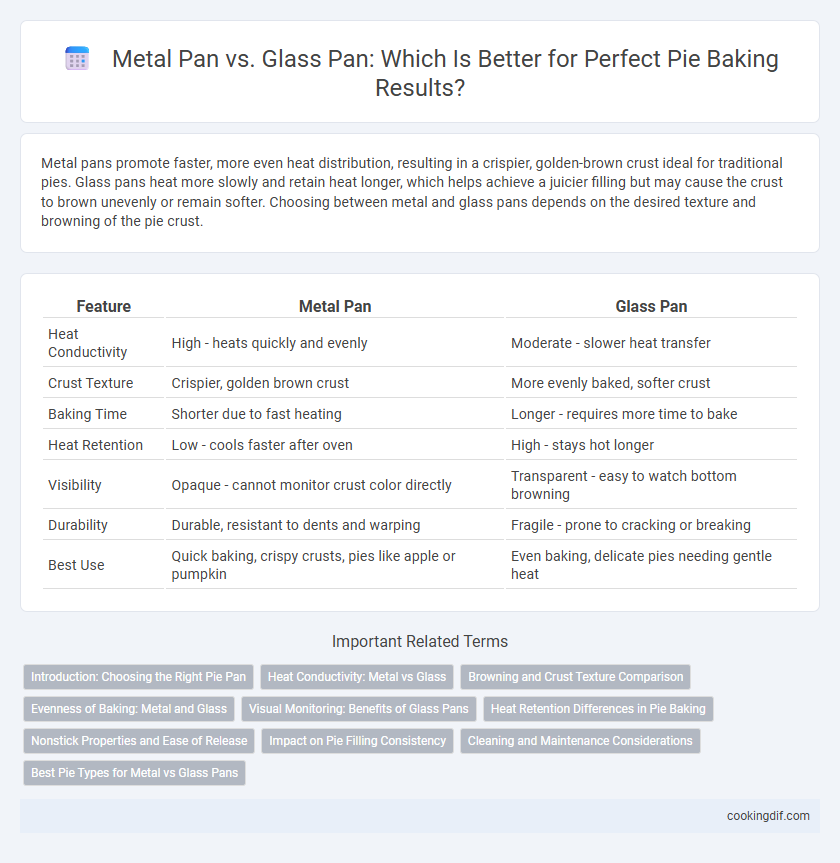Metal pans promote faster, more even heat distribution, resulting in a crispier, golden-brown crust ideal for traditional pies. Glass pans heat more slowly and retain heat longer, which helps achieve a juicier filling but may cause the crust to brown unevenly or remain softer. Choosing between metal and glass pans depends on the desired texture and browning of the pie crust.
Table of Comparison
| Feature | Metal Pan | Glass Pan |
|---|---|---|
| Heat Conductivity | High - heats quickly and evenly | Moderate - slower heat transfer |
| Crust Texture | Crispier, golden brown crust | More evenly baked, softer crust |
| Baking Time | Shorter due to fast heating | Longer - requires more time to bake |
| Heat Retention | Low - cools faster after oven | High - stays hot longer |
| Visibility | Opaque - cannot monitor crust color directly | Transparent - easy to watch bottom browning |
| Durability | Durable, resistant to dents and warping | Fragile - prone to cracking or breaking |
| Best Use | Quick baking, crispy crusts, pies like apple or pumpkin | Even baking, delicate pies needing gentle heat |
Introduction: Choosing the Right Pie Pan
Metal pans conduct heat quickly, producing a crisper, golden-brown crust ideal for fruit pies and flaky textures. Glass pans heat more evenly and retain heat longer, resulting in a slower bake that prevents overbrowning and suits custard or cream pies. Selecting between metal and glass depends on the desired crust texture and pie type for optimal baking results.
Heat Conductivity: Metal vs Glass
Metal pans excel in heat conductivity, allowing pies to bake more evenly and achieve a crispier crust due to rapid and consistent heat transfer. Glass pans have lower heat conductivity, resulting in slower, more gradual heat distribution that can prevent burning but may yield a softer, less browned crust. Choosing between metal and glass pans depends on the desired crust texture and baking time, with metal favored for crispness and glass for gentle, even baking.
Browning and Crust Texture Comparison
Metal pans conduct heat more efficiently than glass pans, resulting in a faster, more even browning and a crisper crust for pies. Glass pans heat more slowly but retain heat longer, which can lead to a more evenly baked filling but a less browned, softer crust. For achieving a golden-brown, flaky crust, metal pans are generally preferred, while glass pans benefit pies that require gentle, sustained baking.
Evenness of Baking: Metal and Glass
Metal pans conduct heat efficiently, resulting in faster and more even baking, which helps achieve a crisp, golden crust for pies. Glass pans heat more slowly and retain heat longer, promoting more uniform cooking but sometimes causing the crust edges to brown more quickly than the center. Choosing between metal and glass pans depends on the desired crust texture and baking time precision for the perfect pie outcome.
Visual Monitoring: Benefits of Glass Pans
Glass pans offer superior visual monitoring during pie baking, allowing bakers to observe crust browning and filling consistency without opening the oven. This transparency helps prevent overbaking or undercooking by providing real-time visual cues, resulting in perfectly baked pies. Unlike metal pans, glass pans facilitate precise adjustments based on the pie's appearance, enhancing overall baking quality.
Heat Retention Differences in Pie Baking
Metal pans heat up quickly and provide excellent heat conduction, resulting in crispier pie crusts, especially along the edges, due to faster heat transfer. Glass pans retain heat longer and distribute it more evenly, which helps pies bake thoroughly and develop a uniform golden color but may cause slightly slower cooking times. Choosing between metal and glass pans depends on whether you prioritize crisp crust texture or even baking with heat retention benefits.
Nonstick Properties and Ease of Release
Metal pans typically offer superior nonstick properties due to their textured surfaces and ability to evenly conduct heat, resulting in a crispier crust and easier release of the pie. Glass pans, while providing even baking and attractive presentation, tend to have stickier surfaces that often require additional greasing or use of parchment paper to prevent the pie from adhering. Choosing metal pans enhances ease of release and reduces the need for extra preparation steps, ensuring a cleaner slice and less cleanup.
Impact on Pie Filling Consistency
Metal pans conduct heat rapidly, promoting a crisper crust and more evenly cooked pie filling with less risk of undercooking. Glass pans heat more slowly and retain heat longer, allowing the pie filling to set gently and often resulting in a thicker, more gelled consistency. For custard or fruit pies where filling texture is critical, metal pans typically yield a firmer, well-baked filling, while glass pans encourage a softer, more tender interior.
Cleaning and Maintenance Considerations
Metal pans offer easier cleaning due to their non-porous surface and resistance to staining, allowing quick removal of baked-on residues with standard dish soap and scrubbers. Glass pans, while providing excellent heat distribution, require cautious cleaning to avoid scratching and may retain residue more stubbornly, necessitating soaking or specialized cleaning agents. Regular maintenance of metal pans includes avoiding abrasive cleaners to prevent surface damage, whereas glass pans benefit from gentle handling and occasional vinegar or baking soda treatments to maintain clarity and cleanliness.
Best Pie Types for Metal vs Glass Pans
Metal pans conduct heat quickly, making them ideal for pies with flaky crusts like apple or pumpkin, as they promote a crisp, golden bottom crust. Glass pans heat more evenly and retain heat longer, which benefits custard pies such as pumpkin or sweet potato by ensuring thorough cooking without burning the edges. For fruit pies, metal pans enhance browning and caramelization, while glass pans prevent undercooked fillings by allowing better visibility and heat distribution.
Metal pan vs glass pan for pie baking results Infographic

 cookingdif.com
cookingdif.com